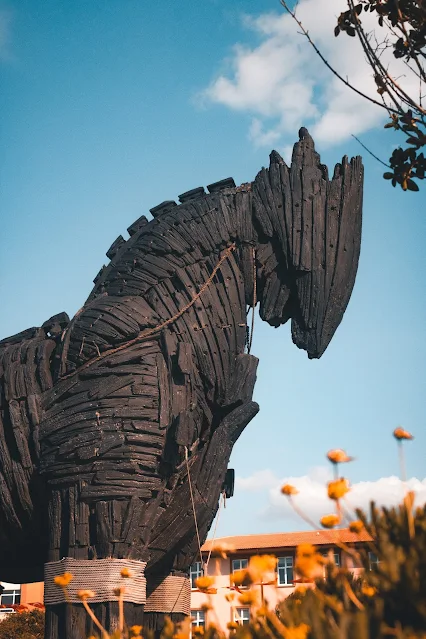Discover the Legends and Ruins of Troy | A Fascinating Turkish Destination
If you are looking for a destination that combines history, culture, and nature, you might want to consider visiting Troy, a legendary city in Turkey that was the setting of the Trojan War. Troy is not only a place of myths and legends, but also a fascinating archaeological site that reveals the layers of civilizations that have inhabited it for thousands of years.
 |
| Trojan Horse |
In this blog post, I will share with you some of the best things to do in Troy and why you should add it to your travel bucket list.
- See the Trojan Horse
Today, you can see a replica of the Trojan Horse at the entrance of the archaeological site. It was built for the 2004 movie Troy starring Brad Pitt and donated to the site by the filmmakers. You can climb up the stairs inside the horse and enjoy a panoramic view of the ruins.
- Explore the Ruins of Troy
The most famous period is Troy VI, which is believed to be the Troy of Homer's Iliad and the Trojan War. You can see the remains of its massive walls, gates, towers, and ramparts that once protected the city from invaders. You can also see the ruins of Troy II, which was discovered by Heinrich Schliemann, a German businessman and archaeologist who excavated Troy in the 19th century. He found a treasure trove of gold, silver, bronze, and jewelry that he claimed belonged to King Priam, the ruler of Troy during the war. However, later research showed that these artifacts were actually from an earlier period and had nothing to do with Priam or Homer.
- Visit the Museum of Troy
- Enjoy Nature at Gallipoli Peninsula
Troy is not only about history and archaeology; it is also surrounded by beautiful nature that you can enjoy during your visit. Troy is located on the Gallipoli Peninsula, which is a narrow strip of land that separates Europe from Asia across the Dardanelles Strait. The peninsula is famous for its role in World War I, when it was the scene of a fierce battle between Turkish and Allied forces. Today, it is a national park that preserves the memory of those who fought and died here.
You can visit some of the monuments, cemeteries, museums, and memorials that commemorate the Gallipoli Campaign. You can also enjoy some outdoor activities such as hiking, biking, camping, fishing, or swimming in one of the many beaches along the coast.
- Experience Local Culture in Çanakkale
Troy is a destination that will appeal to anyone who loves history, mythology, culture, and nature. It is a place where you can immerse yourself in the stories and legends of the past, while also enjoying the present and the future. Troy is a place that you should not miss when you visit Turkey.
FAQs
Where is Troy located?
Troy is located in modern-day Turkey, near the city of Çanakkale on the Gallipoli Peninsula.
Why is Troy famous?
Troy gained fame as the setting of the Trojan War, a legendary conflict described in Homer's epic poem, the Iliad. It is also renowned for its archaeological significance, representing thousands of years of human history.
Can I see the Trojan Horse in Troy?
Yes, you can see a replica of the Trojan Horse at the entrance of the archaeological site. The wooden horse was built for the movie Troy and provides a unique vantage point to appreciate the surrounding ruins.
What can I explore in the ruins of Troy?
The ruins of Troy reveal nine different periods of settlement, with Troy VI being the most famous and associated with the Trojan War. Visitors can observe remnants of walls, gates, towers, and other structures that once formed the ancient city.
Is there a museum in Troy?
Yes, the Museum of Troy opened in 2018 near the archaeological site. It houses over 2,000 artifacts discovered in Troy and its vicinity, offering insights into the region's history from prehistoric to Roman times.
What else can I do around Troy?
The Gallipoli Peninsula, where Troy is situated, offers picturesque natural landscapes. Visit monuments and museums commemorating World War I's Gallipoli Campaign, engage in outdoor activities like hiking and camping, or experience the local culture in Çanakkale, a nearby seaside town.
How far is Troy from Çanakkale?
Troy is approximately 30 kilometers away from Çanakkale, making it easily accessible for a day trip or an extended stay.
Is Troy a UNESCO World Heritage Site?
Yes, Troy was inscribed as a UNESCO World Heritage Site in 1998 due to its exceptional cultural and historical significance.
Are there any events or festivals in Troy?
While specific events may vary, Troy and Çanakkale host various festivals throughout the year, providing opportunities to immerse yourself in local traditions, art, and cuisine.
Why should I visit Troy?
Troy offers a unique blend of history, mythology, culture, and natural beauty. From exploring ancient ruins to witnessing the iconic Trojan Horse, from delving into the museum's artifacts to embracing local hospitality, Troy provides an unforgettable experience for travelers interested in Turkey's rich heritage.
Turkey Unleashed: A Traveler's Guide to Embracing Turkish Culture, Cuisine and Etiquette



Comments
Post a Comment
It's easy to leave a comment on our blog – anyone with a Google account can do it. We invite you to share your experiences by leaving a comment as well.